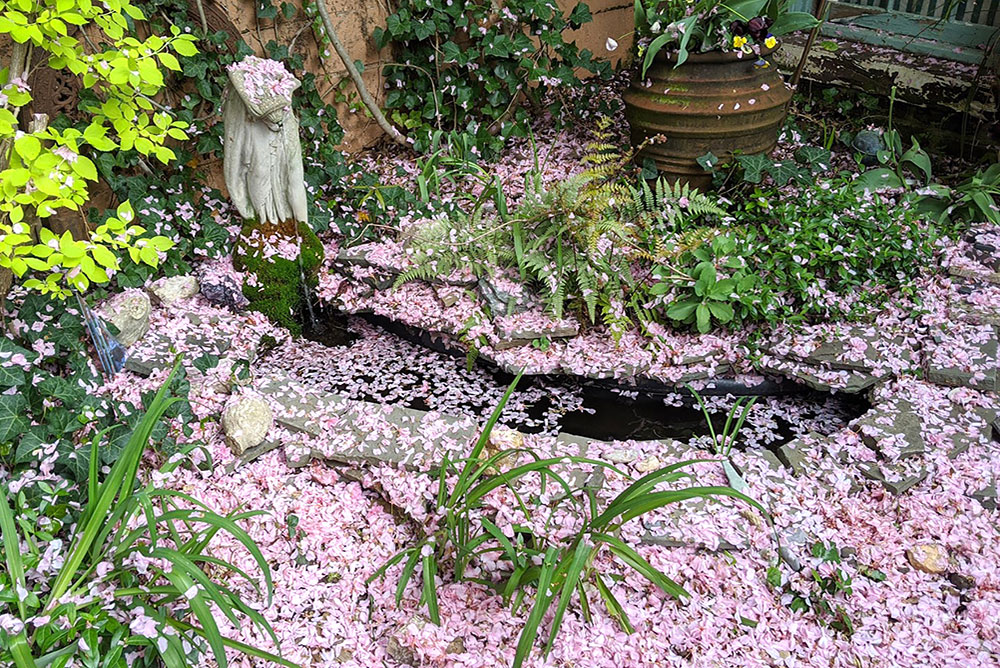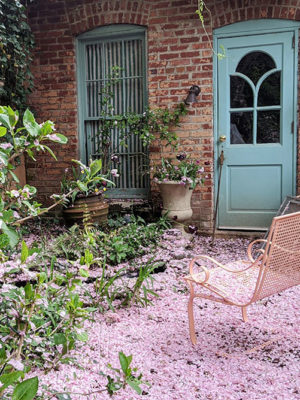
It’s hard to see the little koi pond for all the cherry blossoms. / Photo by Stephanie Cavanaugh.
SNOW AT LAST!
It’s an inch or so deep in the backyard and pink as a ballerina’s tutu. The blossoms are falling from the Kwanzan cherry, covering the pond, the stone path, the flower borders. It’s gorgeous today, and will be tomorrow, but by the weekend it will be as glamorous as snow drifts after a warm week. Brown and slushy underfoot, unpleasant.
The tree had a reasonable run this year, the flowers opening around the first of April—two weeks earlier than usual—and only now beginning to shed its candy-colored puff balls. Monday was particularly beautiful, with patches of torrential rain followed by brilliant sunshine, the winds whipping up showers of petals mingling with the raindrops. Having nothing much else to do, I watched.

Snow in April! The Kwanzan tree shed its pink beauty all over the Cavanaugh backyard. / Photo by Stephanie Cavanaugh.
Confinement is a curious thing. A few weeks ago, at the start of it all, I wrote about cooking with whatever’s to hand. Getting creative with bits of this and that, which (in a previous life) would have been allowed to grow fur before discarding (one can’t just toss perfectly good food, can one? it has to be beyond saving). Now that bite of green pepper will flavor tomorrow’s concoction or maybe whatever I invent the day after. Why, I can probably build an entire meal around it. Who knew?
Such is also true in the garden. Normally, around about now we’d be planning a trip to Raleigh, North Carolina (land of the fried Ho Ho) to visit Baby and her Personal Prince Pete, wee grandbaby Wes and granddog Tallula, and make the rounds of the State Farmers Market and flower centers, which should already be bursting with plants and flowers, filling the truck bed with a summer’s haul. We are, instead, here, squinting at Baby and the others on a tiny phone screen, which is better than nothing, I suppose.
We tried a few days back to visit Ginkgo, our neighborhood gardening emporium, but most of the joy is gone when there’s no time to putter and mull; to pick up an eye-tempter and meander about the rows, considering what goes with what and where. Now we masked gardeners are being allowed in one at a time, the crowd outside (since when is 10 people a crowd?) patiently waiting a turn. Mustn’t hold up traffic.
I quickly snapped up seeds: poppies, cosmos, cleome, bishop’s lace, sweet peas and moonflowers, with no particular idea of where they’ll go but envisioning the sweet and sweet-smelling bouquet they’ll make. Suddenly, I felt so rich. And what fun it was to shop. Shop!
If I can’t take the time to mull in the garden center, I have all the time in the world to mull at home. What can I do with what I have? When the supply lines are crimped, my brain becomes surprisingly fertile.
For umpteen years there’ve been sweet-potato vines in the center of the window boxes, some years an acid green, others a blackish purple. By fall they’ve ruffled their way down from the second floor, frilled ends visible through the living room windows. Those in the lower boxes puddle on the porch floor.
This year I find I have a fabulous mass of asparagus fern, a modest patch that exploded over the winter in the greenhouse. Digging it out of the pots and sawing the roots, I had five voluptuous sprays for the front of the boxes. This was instantly stunning, in a way I normally wait months to achieve.
Instead of my usual debate (entirely internal but terribly fraught) over what I should put in the back, I clipped five generous branches of schefflera, dipped the stems in growth hormone and jabbed them into the boxes. Flanking these are branches of geranium, also overwintered and hormone-dunked. And in the corners of each box, ivy twines (or raggedly hangs, depending on the appetite of the pigeons and squirrels. Why do they like only some of the ivy, not all?).
So many common houseplants can be divided or easily rooted in water or with a bit of hormone (if you’re lacking the store-bought stuff, honey is said to inspire roots). You can make much out of little, with no splicing, splinting or what-notting necessary—it’s instant gratification, or near to it.
What many consider the bible of subdivision is Plant Propagation by Alan Toogood, published by the American Horticultural Society and apparently out of print, though available used on Amazon. The British horticulturist (you know you can always trust a Brit in these matters) has tips for propagating more than 1,500 plants—from snip and stick the stem in the soil to fussing for a summer or six hoping for a bud.
Though having nothing much better to do at the moment you might take on the challenge.
—Stephanie Cavanaugh
LittleBird “Stephanie Gardens” has time these days to get creative with the window boxes.
MyLittleBird often includes links to products we write about. Our editorial choices are made independently; nonetheless, a purchase made through such a link can sometimes result in MyLittleBird receiving a commission on the sale, whether through a retailer, an online store or Amazon.com.

or just use spray paint 🙂
Honey will inspire roots….indeed!!!! like that one
Growth hormone for plants? Okay. Anyway, I’ve got some lavender, some of which growing beautifully, with no dead stuff around it. Other plants have old, dead stuff in the middle. Do I just prune the middle of those plants?
Wish I could be dipped in a hormone – so I would blossom out of lockdown inertia!
I am headed to the cabinet in search of honey!